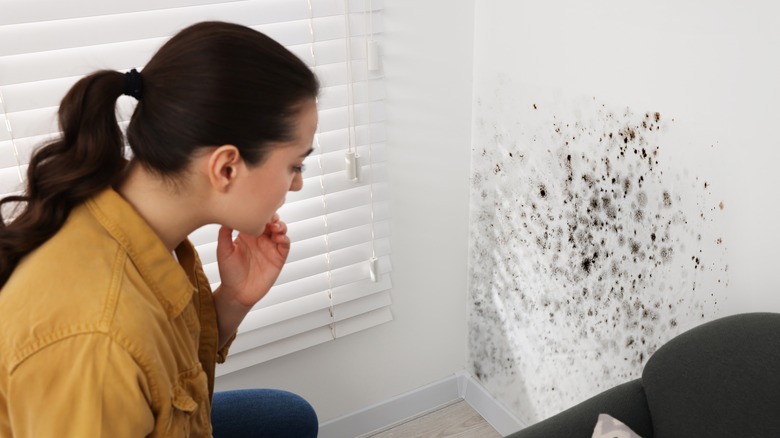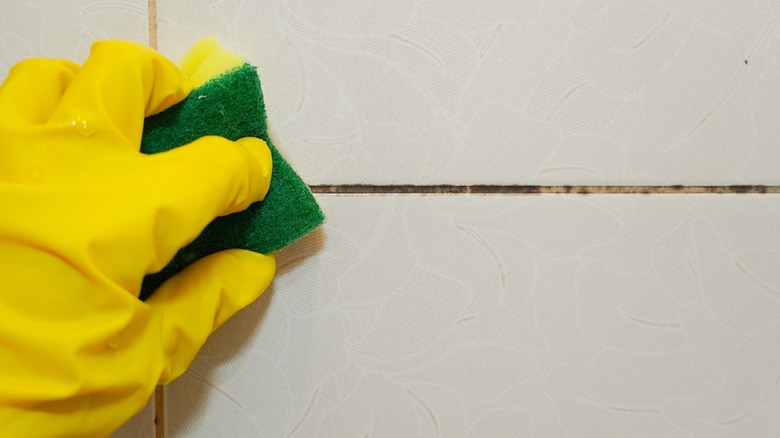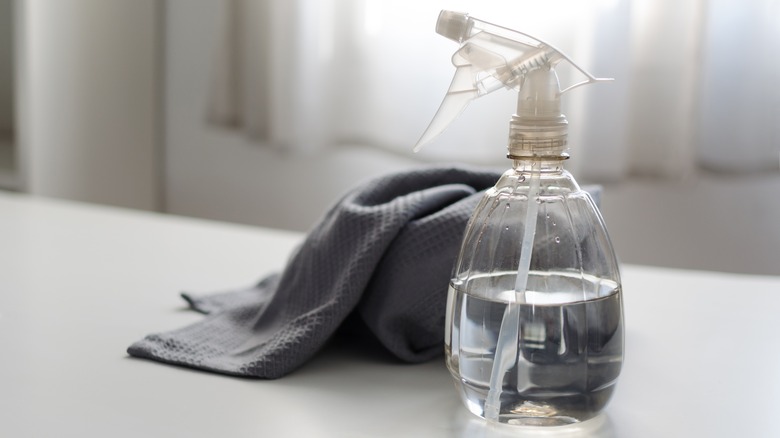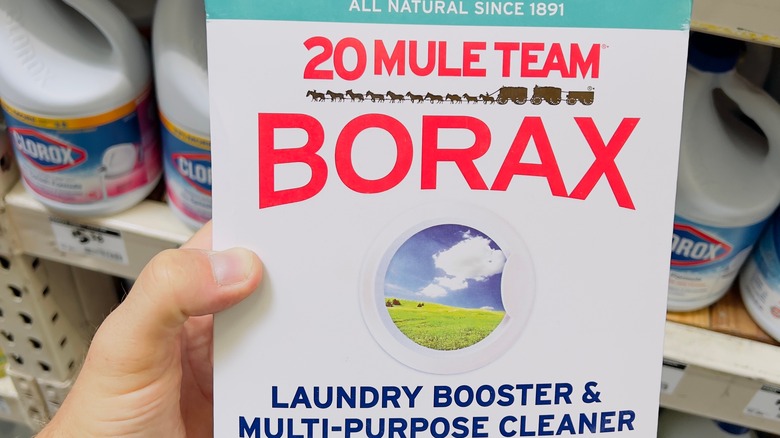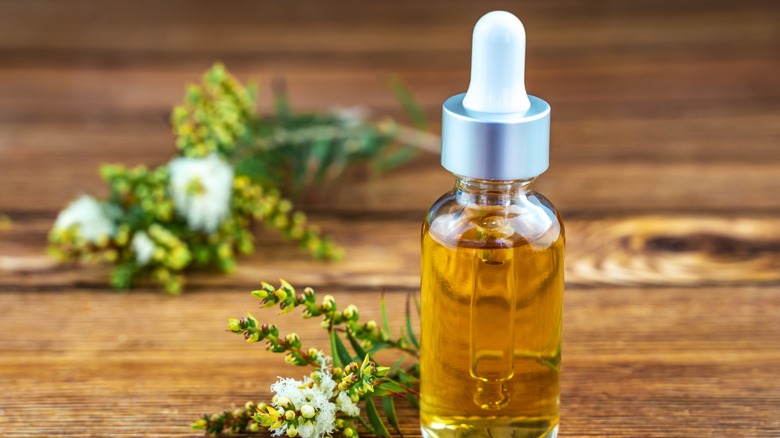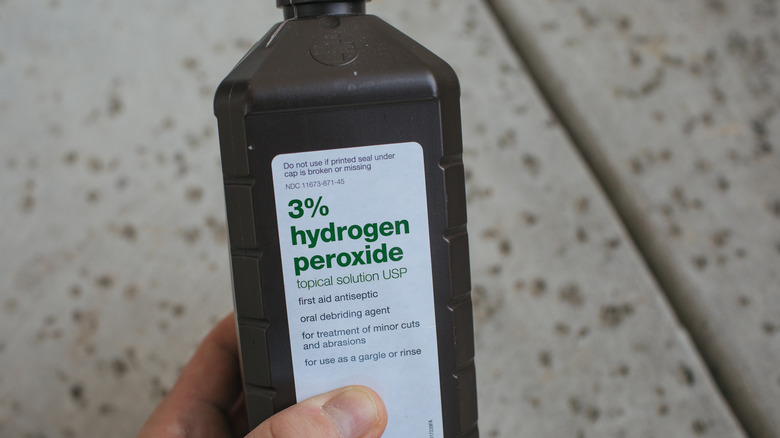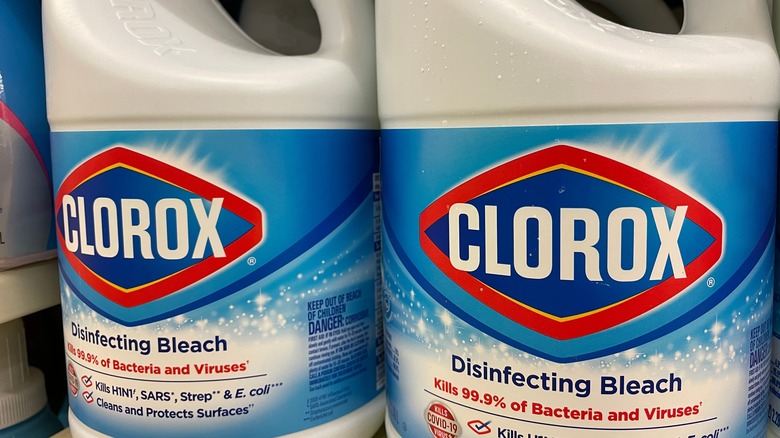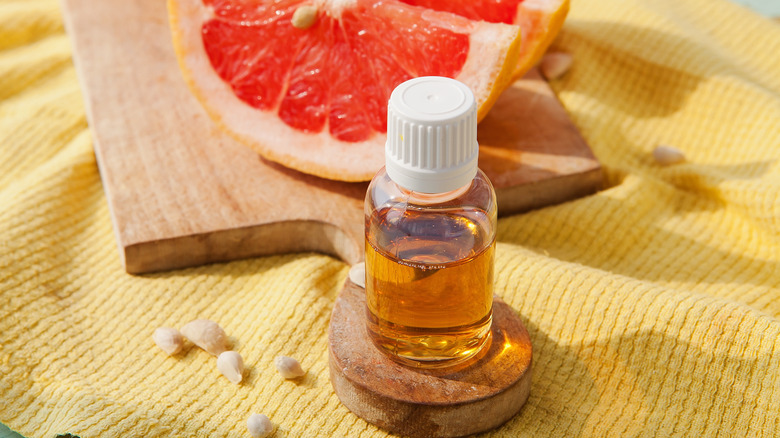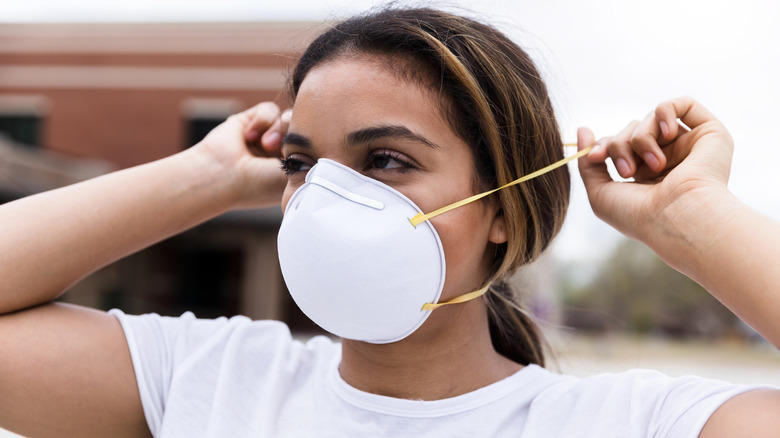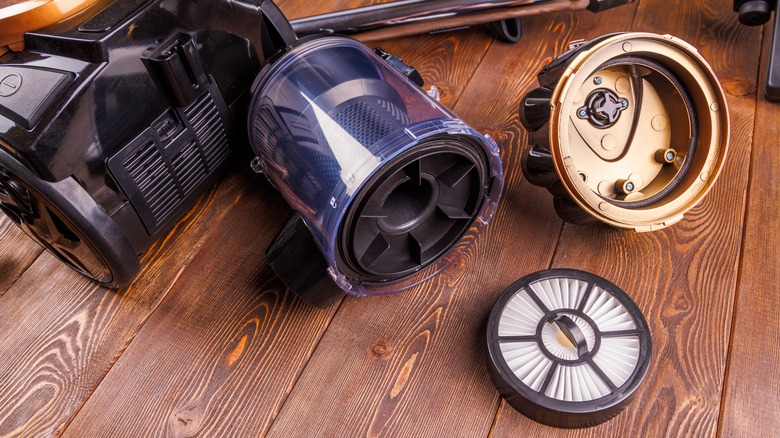9 DIY Ways To Remove Mold In And Around Your Home For A Fresher Space
We may receive a commission on purchases made from links.
We know you're careful to maintain a clean and healthy home environment. But despite your efforts, mold can grow in overly moist areas. This living fungus that spreads via spores poses potential health concerns for you and your family. The Federal Emergency Management Agency (FEMA) reports that the dangers of mold growth in your home are twofold. It not only produces health risks but also damages the integrity of your home. According to the U.S. Environmental Protection Agency, the adverse health effects of mold include allergic reactions like runny nose, sneezing, asthma attacks, irritated eyes, and skin rashes. The symptoms may arise from either touching or inhaling mold or mold spores. Children, the elderly, and those with pre-existing illnesses are most vulnerable.
Given the serious nature of mold growth, it's crucial to take immediate action when you detect it on any surface in your home. But instead of resorting to chemical-laden commercial products for removal, you can opt for chemical-free cleaning agents to maintain a fresh and mold-free home. We've compiled a list of natural, mold-fighting interventions, all of which are not only safe but also highly effective. Ahead, you'll discover readily available, homemade cleaners with ingredients like vinegar, tea tree oil, and hydrogen peroxide that provide powerful ways to clean mold in your home.
Remove mold from nonporous surfaces with all-purpose detergent and water
According to the U.S. Environmental Protection Agency, mold is a living fungus capable of spreading via spores that float through the air. It can thrive on any surface in the presence of sufficient moisture and oxygen. If you identify mold in your home growing on hard, nonporous surfaces, the removal process is fairly easy with detergent and water.
Nonporous surfaces include glass, plastic, tile, and metal materials. Additionally, a wood surface that is thoroughly sealed and varnished may be considered non-porous. The mold growth on these hard materials remains on the surface; it can't penetrate deeper underneath. For this reason, you can get rid of it by simply washing the surface with detergent and rinsing it thoroughly. Soap doesn't actually kill the spores, but it's an emulsifier that effectively lifts debris from surfaces so you can easily wipe it away. Once done scrubbing, it's important to rinse and dry the area. You can deter future mold growth by thoroughly drying the hard material and keeping it dry.
Distilled white vinegar kills mold on both porous and nonporous surfaces
The Mississippi State University Extension reports that the acetic acid in distilled white vinegar kills 82% of all mold species. In addition to its efficacy, this cleaning agent is natural, non-toxic, inexpensive, and readily available in grocery stores. Users who dislike the smell of vinegar find that adding a few drops of essential oils or lemon juice to it solves the odor problem. Distilled white vinegar eliminates mold on hard surfaces, and it offers the advantage of killing the roots of the mold when they penetrate porous materials.
The acetic acid in vinegar boasts anti-fungal properties along with a strong pH of 2.5. Its chemical make-up allows vinegar to kill many species of mold, fungus, and other organisms. Applying distilled white vinegar to a moldy area in your home couldn't be easier. Simply pour the undiluted vinegar into a spray bottle and spray it directly onto the mold. Let it sit on the surface for at least 15 minutes to an hour before wiping it clean and allowing the area to dry out.
Alternatively, you can dilute the vinegar with water in a 1:1 ratio before spraying it onto the mold. Whether you're working with straight or diluted vinegar, it's a good idea to wear gloves, a face mask, and an apron while you're cleaning the moldy area. The protective gear will guard against inhaling mold spores that cause respiratory problems.
Reach for the Borax to put sodium borate to work against mold
You might think of Borax as the laundry detergent that's been around for more than 100 years. It contains the compound sodium borate, made from the natural mineral Boron along with sodium and oxygen. This compound gives Borax its powerful cleaning capabilities and makes it an effective mold killer. Although it is toxic if swallowed, Borax does not give off fumes or an offensive odor. In fact, it can be used as a natural deodorizer for drains and toilets as well as an insecticide and fungicide.
Borax is a white powder that must be diluted with water before you use it for cleaning. The sodium borate in Borax stops the growth of mold by inhibiting its reproduction processes. To remove mold, mix 1 cup of Borax with 1 gallon of warm water. Saturate the moldy area with the cleaning mixture and scrub it with a sponge or brush. Then, wipe the area to remove loose mold spores, but don't rinse away the Borax. Instead, leave it to dry on the surface. Borax is most effective on non-porous surfaces, such as tile, tubs, and showers. Even though it's a natural product, it's best to wear gloves when working with it to reduce irritation.
Tea tree oil functions as an antifungal agent to safely kill mold spores
Tea tree oil (Melaleuca alternifolia) is distilled from the leaves of the tea trees that grow in Australia. For centuries, it has been used topically as an antiseptic and medicine for health-related skin conditions. In a 2015 scientific study, researchers found that tea tree oil effectively remediates fungus contamination, such as mold, in residences and occupational buildings. The effectiveness of Melaleuca alternifolia in removing mold is likely linked to its antimicrobial capabilities. Although it has a strong odor, tea tree oil does not emit harmful fumes. However, it's best to use it as a mold remover in limited amounts with ample ventilation.
You can use tea tree oil in your home as both a mold remover and a mold-prevention agent in moist areas like bathroom shower walls, tiles, and faucets. To apply it, mix 1 teaspoon of tea tree oil with 1 cup of water in a spray bottle. Simply spray the mixture on the surface and wipe it dry with a cloth. Although tea tree oil is most effective on nonporous surfaces, it can be used on porous materials as well. For mold on fabrics, add a few drops of tea tree oil to the laundry cycle in your washer. In addition to cleaning the clothing, it removes mold from the washing machine. Be aware that although it's non-toxic for regular use, tea tree oil is poisonous if swallowed.
Hydrogen peroxide is a known mold fighter, but don't mix it with vinegar
Home cleaners who prefer natural products are familiar with hydrogen peroxide, a liquid that's usually packaged in an opaque brown bottle. Its chemical formula is H2O2. Notably, it's the same as water (H2O), with one extra oxygen molecule. This feature makes hydrogen peroxide act as an oxidizing agent to clean and disinfect a variety of both porous and nonporous surfaces. This liquid is capable of killing mold spores as well as bacteria and viruses. When hydrogen peroxide is applied to mold, it releases oxygen rapidly. This action causes the surface of the mold to oxidize and decompose. Although you can remove mold with hydrogen peroxide, it might not kill the underlying roots of the fungus.
Hydrogen peroxide can be used to clean mold from rugs and carpets, although it may produce a mild bleaching effect. To kill mold on hard surfaces, spray undiluted hydrogen peroxide onto the area and wait 10-to-15 minutes. When the liquid stops bubbling, you can scrub the mold away with a cloth or brush. There's no need to rinse the area before drying it. When you're working with hydrogen peroxide, it's a good idea to wear gloves and goggles. It can be harmful if it comes in contact with your skin and eyes. As an additional warning, you should never mix hydrogen peroxide with vinegar. The result is the formation of peracetic acid that causes irritation to the skin, eyes, and respiratory system.
Take precautions if you use bleach to remove mold
Bleach is a known mold fighter, but using it presents several problems. Contact with bleach is harmful to your skin and eyes, and inhaling the fumes can irritate your respiratory system. On top of that, bleach removes the color from many materials and corrodes metals. However, the careful use of bleach may be a good choice in some cases, due to its disinfecting properties. Bleach is a useful sanitizer because it's a known biocide that controls viruses, bacteria, and fungi. However, some experts warn that while it might clean away mold on surfaces, it may not kill the mold roots, allowing it to re-grow.
If you decide to use bleach for mold removal, be sure to clean the area with soap and water first, as soil and debris can impede the effectiveness of the bleach. Then, mix ½ to 1 cup of household laundry bleach with 1 gallon of water. Always work with a thoroughly diluted solution of bleach and water. Straight bleach will not have a stronger effect on the mold. You can spray the solution onto hard surfaces or apply it with a cleaning sponge or cloth. There's no need to rinse the surface unless it will be used for food prep or may be touched by small children. Be aware that while bleach can be an effective mold-fighting agent, it does not kill the roots of the mold in porous materials.
There are several precautions to take before cleaning your home with bleach. It's important to provide ample ventilation and to wear eye protection, rubber gloves, and clothing that covers your body. Never mix bleach with ammonia, as it creates a toxic gas.
Grapefruit seed extract offers natural mold-killing properties
Here's a less well-known ally in the battle against household mold. It not only removes mold, but it acts as a preventive to deter future mold growth. Made from grapefruit seeds and pulp dissolved in glycerin, liquid grapefruit seed extract is available online and in stores, including Nutribiotic GSE from Walmart. The citric acid in GSE gives it the ability to eliminate fungi such as mold. Citric acid works by penetrating the cell walls of mold spores, killing them immediately. Although it's more expensive than other anti-fungal cleaning agents, GSE is safe and natural without emitting a strong odor. Additionally, it's effective in small amounts, off-setting the high cost.
To remove mold and guard against future mold growth, mix 10 drops of grapefruit seed extract with one cup of water in a spray bottle. Shake well, and spray the solution onto the mold. Wait 1 to 2 hours and then wipe the area with a clean cloth. You'll not only remove the mold, but the GSE will also disinfect and deodorize the area where it's applied.
Scientific evidence for the efficacy of GSE as a mold killer is mixed. In a scientific study, researchers found that GSE exhibits antibacterial properties to destroy a wide variety of bacteria biotypes. However, in a study of grapefruit seed extract's effects on fungi, it showed only weak anti-fungal effects against mold. Be aware that some GSE products contain numerous additives. For this reason, you'll want to look for pure, all-natural GSE.
Use these safe methods to discard mold-damaged, porous materials from your home
When mold grows in your home, it's due to excessive moisture and inadequate ventilation. Mold problems can arise due to high humidity, water overflow in bathrooms, lack of exhaust fans in kitchens, unvented clothes dryers, and leaky air conditioners. Add to the list the possibility of roof leaks, flooding, and overflowing gutters due to storms, and you can imagine many scenarios where mold growth poses significant structural and health-related problems. While it's generally possible to kill the mold that grows on nonporous surfaces, it may be impossible to salvage the porous materials damaged by mold. These include carpets, padding, mattresses, insulation, wall board, ceiling tiles, and more. Instead of trying to kill the mold, the best course of action is to remove those items from your home and safely dispose of them.
When you move moldy materials, the spores are released into the air where they travel great distances on air currents. To minimize the negative health effects, you should take precautions when removing mold-damaged items. If an item is small enough, you can place it in a plastic garbage bag and seal it tightly with tape. Large items may not fit in plastic bags. Wrap them in 6-millimeter plastic sheeting like the HDX plastic from The Home Depot and seal them with Gorilla Black duct tape. While you're working with moldy materials, you should wear protective gear like the Makrite N-95 mask from Walmart along with O-Cedar Playtex Living gloves.
After cleaning moldy areas, use a HEPA filter vacuum to remove mold spores
The U.S. Environmental Protection Agency (EPA) defines a high efficiency particulate air (HEPA) filter as one that removes at least 99.97 percent of dust, pollen, mold, bacteria, and other airborne particles as small as 0.3 microns. That's why a vacuum cleaner with a HEPA filter is an important tool for removing the mold from your home. The filter will trap the mold spores to prevent respiratory health problems as well as continued mold growth.
Use a HEPA filter vacuum to pick up loose dirt and debris before you proceed to clean a moldy surface with liquid cleaning solutions like detergent, vinegar, or diluted Borax. After you finish cleaning, use the HEPA vacuum again to collect any residue and mold spores that may be left behind. When you change the HEPA filter in the vacuum, it's important to minimize contact with the mold. For this reason, you should wear an N-95 mask along with eye protection and rubber gloves. Dispose of the filter's contents in sealed plastic bags to prevent the mold spores from spreading.
